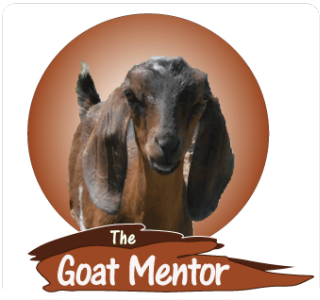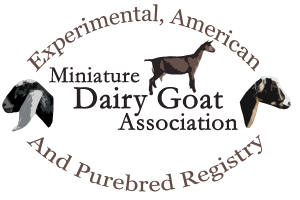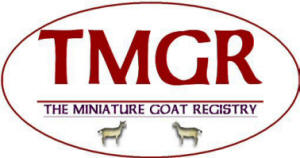Breeding MiniNubians
(or any other Mini Dairy Goat breed - just change the standard breed and breed character traits for that breed)
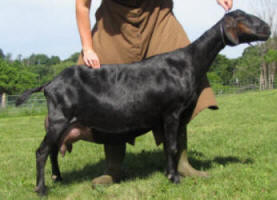 MiniNubians
are a fairly new breed of dairy goat. They originate from Nigerian
and Nubian dairy goats. The MiniNubians are bred to look like a Nubian
but to be much smaller. They are not as small as a Nigerian, but are
not as large as a standard Nubian. They are to be very good milkers
on minimal feed that are hardy, well mannered, friendly, and small.
MiniNubians
are a fairly new breed of dairy goat. They originate from Nigerian
and Nubian dairy goats. The MiniNubians are bred to look like a Nubian
but to be much smaller. They are not as small as a Nigerian, but are
not as large as a standard Nubian. They are to be very good milkers
on minimal feed that are hardy, well mannered, friendly, and small.
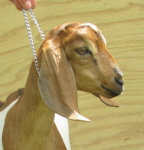 The breed characteristics that set the MiniNubian apart are the same as
their full sized cousins – long, pendulous, bell shaped ears and a roman
nose. They should have well built udders that will hold up to years
of production and be easy to milk. The main difference between a full
sized Nubian and a MiniNubian is their height – Full sized Nubians have
a minimum height of 30 inches for does and 35 for bucks and they can get
MUCH taller with many weighing over 200#. The MiniNubians on the other
hand are typically around 23-26 inches for does and around or just under
100#. Their smaller size makes them much easier to handle. This
article will walk you through the process of breeding for these wonderful
little animals.
The breed characteristics that set the MiniNubian apart are the same as
their full sized cousins – long, pendulous, bell shaped ears and a roman
nose. They should have well built udders that will hold up to years
of production and be easy to milk. The main difference between a full
sized Nubian and a MiniNubian is their height – Full sized Nubians have
a minimum height of 30 inches for does and 35 for bucks and they can get
MUCH taller with many weighing over 200#. The MiniNubians on the other
hand are typically around 23-26 inches for does and around or just under
100#. Their smaller size makes them much easier to handle. This
article will walk you through the process of breeding for these wonderful
little animals.
Select your foundation animals. You can either choose to start from scratch with your own line of MiniNubians and begin with Nigerian and Nubians, or you can purchase MiniNubians from an established herd. Either way you go, be sure to get the best possible animals you can. Make sure you are looking at milk production, conformation and personality. These animals will be the foundation for your herd and your reputation as a breeder. If you start with animals with bad conformation and not very much milk, their offspring will carry those traits even if bred to a goat with good genetics. Bottom line is: Find the best foundation animals you can! You will be glad you did. See here for a complete article on choosing a dairy goat.
Starting with the foundation breeds (Nigerian and Nubian),
will allow you to bring in new bloodlines and you can start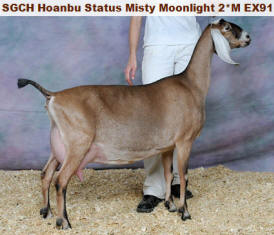
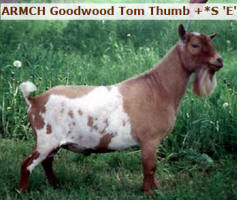 your
own line of MiniNubians. The first generation is usually
created by breeding your high quality Nigerian buck to a wonderful Nubian
doe (not the other way around with a big buck to a little doe - this can
result in kidding problems). The resulting kids will
be first generation, 50/50. The 50/50 shows the percentage
of Nubian and Nigerian – 50%Nubian and 50%Nigerian. The
generation notes how far they are from the original cross.
The kids are always one generation higher than the lowest generation
parent - the foundation breeds (Nigerian and Nubian) are considered ‘0 generation’.
1st generation can also be noted
as ‘F1’. For more information on generations and pedigrees, view this
your
own line of MiniNubians. The first generation is usually
created by breeding your high quality Nigerian buck to a wonderful Nubian
doe (not the other way around with a big buck to a little doe - this can
result in kidding problems). The resulting kids will
be first generation, 50/50. The 50/50 shows the percentage
of Nubian and Nigerian – 50%Nubian and 50%Nigerian. The
generation notes how far they are from the original cross.
The kids are always one generation higher than the lowest generation
parent - the foundation breeds (Nigerian and Nubian) are considered ‘0 generation’.
1st generation can also be noted
as ‘F1’. For more information on generations and pedigrees, view this
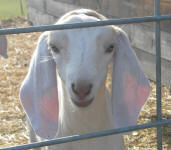 Once
you have your first generation of MiniNubians, now what?
Once
you have your first generation of MiniNubians, now what?
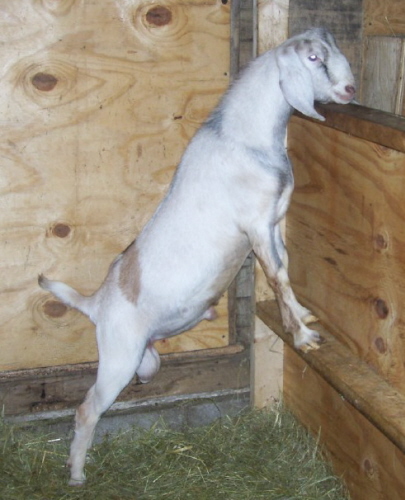 The 1st generation 50/50 kids can be bred to another MiniNubian (of
any generation) for 2nd generation kids. Or they can
be bred back to a Nubian. Usually this is only buck kids
bred to Nubian does. The reason for this breeding is
to get better breed character. The kids from this cross
will be 75/25 – 75% Nubian and 25% Nigerian. This usually
results in much better breed character than the first 50/50 cross.
They may get a little on the taller side, so the next step with these
is…to breed these 1st generation 75/25 kids to another MiniNubian with a
lower percentage of Nubian. I recommend breeding them
to a 50/50 MiniNubian. That will give you a percentage
around 60/40 which seems to be the best for getting the breed character
we are looking for and still keeping the size down. The buckling pictured
to the left is an example of the breed character you can get with 75/25
- he did get large though - He is shown as a yearling on the right.
The 1st generation 50/50 kids can be bred to another MiniNubian (of
any generation) for 2nd generation kids. Or they can
be bred back to a Nubian. Usually this is only buck kids
bred to Nubian does. The reason for this breeding is
to get better breed character. The kids from this cross
will be 75/25 – 75% Nubian and 25% Nigerian. This usually
results in much better breed character than the first 50/50 cross.
They may get a little on the taller side, so the next step with these
is…to breed these 1st generation 75/25 kids to another MiniNubian with a
lower percentage of Nubian. I recommend breeding them
to a 50/50 MiniNubian. That will give you a percentage
around 60/40 which seems to be the best for getting the breed character
we are looking for and still keeping the size down. The buckling pictured
to the left is an example of the breed character you can get with 75/25
- he did get large though - He is shown as a yearling on the right.
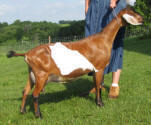 After
breeding your first generation kids to another MiniNubian, you now have
2nd generation MiniNubians, either 50/50 or a different percentage.
You’ve had a little time to experiment and see what your animals
are producing. By this point you do not really have to
worry about the percentages any more (as long as you are below 70% of either
foundation breed) - you should be selecting kids based on conformation,
breed character, size and personality. You can now get
to 3rd generation by breeding your 2nd gen MiniNubian to a 2nd or higher
generation MiniNubian. Just remember that getting higher
generations is not the main goal – choose the buck that will be the best
fit for your doe in all areas – not just generations.
It is better to go back a few generations and improve conformation,
milk, breed character etc. than to continue up the 'generation ladder'
and loose quality. For more on this, please read 'How
to think about generations'
After
breeding your first generation kids to another MiniNubian, you now have
2nd generation MiniNubians, either 50/50 or a different percentage.
You’ve had a little time to experiment and see what your animals
are producing. By this point you do not really have to
worry about the percentages any more (as long as you are below 70% of either
foundation breed) - you should be selecting kids based on conformation,
breed character, size and personality. You can now get
to 3rd generation by breeding your 2nd gen MiniNubian to a 2nd or higher
generation MiniNubian. Just remember that getting higher
generations is not the main goal – choose the buck that will be the best
fit for your doe in all areas – not just generations.
It is better to go back a few generations and improve conformation,
milk, breed character etc. than to continue up the 'generation ladder'
and loose quality. For more on this, please read 'How
to think about generations'
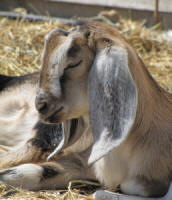 At
3rd generation your MiniNubian can apply for American registration status
if they meet the breed standard – they must have the correct breed character
(see standard below); they should LOOK like a Nubian but be smaller. They
must also be likely to stay with in the height requirements (you can get
an idea of this from the parents) and be under 70% of either foundation
breed. The buckling to the left is a 4th gen American showing ideal breed
character.
At
3rd generation your MiniNubian can apply for American registration status
if they meet the breed standard – they must have the correct breed character
(see standard below); they should LOOK like a Nubian but be smaller. They
must also be likely to stay with in the height requirements (you can get
an idea of this from the parents) and be under 70% of either foundation
breed. The buckling to the left is a 4th gen American showing ideal breed
character.
Here are the MiniNubian Breed Character requirements from the MDGA website: "The breed character setting the Mini-Nubian apart from other Mini's is a nose that is never dished, but straight to strongly convex (with the strongly convex being more desirable). And distinctive, long, wide, and pendulous ears that when held along the face reach the end of the nose. They should be held close to the head where they attach and then widen and flare out and forward to a rounded tip, making the classic "bell" shaped ear standard Nubians are so well known for." See the full standard here.
After breeding for many generations and getting 3 generations of American MiniNubians, your 6th gen or higher kids may be eligible for registration as Purebred. Again, they must meet the same qualifications as for American (breed character, height and percentage), but must also have a solid 3 generations of American MiniNubians behind them. In other words, their parents, grandparents and great-grandparents must all be Americans. Complete requirements for American and Purebred registrations can be seen on the MDGA website here.
Choose the best breeding stock possible – look at milk records, classification/Linear appraisal scores and meet the animal for personality evaluation if possible. Click here for help with understanding milk stars (*B, *M etc.), championship awards and linear appraisal scores.
When choosing your Nubian foundation doe you will want to make sure she is a good representative of her breed – look for good breed character (long, wide, soft ears and a roman nose) in addition to good conformation and milk production. When breeding her to a Nigerian, it will be difficult enough to get the good breed character, and if you start with poor breed character, it will be even harder to get it in the offspring.
Do not choose Nubians that have been stunted. They are still genetically large and will throw large kids.
After your first cross of Nigerian to Nubian, you can continue breeding your Nubian does to your Nigerian buck for more 50/50 1st gens, or breed them to a MiniNubian buck for 75/25 kids
Enjoy the adorable kids!
NOTE: MiniNubians CANNOT be bred using a Pygmy instead of a Nigerian - a Pygmy/Nubian cross is called a Kinder goat and is a dual purpose goat, not primarily a dairy goat.
